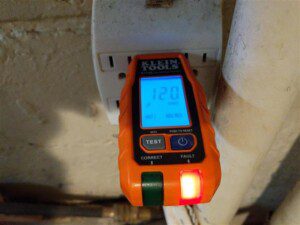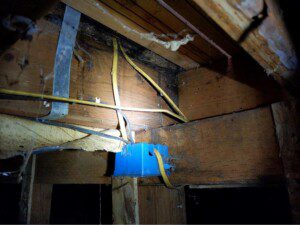During a home inspection, home inspectors often encounter varying electrical defects. Some of these conditions can be major, oftentimes they are minor deficiencies, but carry potentially dangerous consequences.

An ungrounded three-prong outlet increases the potential for shocks or electrocution and may prevent some sensitive electrical equipment, such as surge protectors, from operating correctly. Some people will attach a jumper wire between the neutral wire and ground connection, believing that it’s ok because they’re connected to the same bus bar in the main electrical panel, this is known as a bootleg ground. This is also done to avoid open grounds and to allow the use of a three-prong connector in a three-prong receptacle, without paying an electrician to wire it correctly. This configuration will show up on most electrical testers as a valid ground, even though it isn’t.
The easiest alternative to rewiring a bootleg ground is to install a GFCI receptacle in place of an ungrounded outlet and put stickers on the plate saying “GFCI protected” and “No equipment ground”. Most GFCI receptacles should come with these stickers when purchased. The NEC and most local codes allow this practice.
Another common mistake is reversed polarity. This occurs when the hot and neutral wires are flipped around at an outlet, or upstream from an outlet. Reversed polarity creates a potential shock hazard. The reason reversed polarity is hazardous, actually lies in the electrical appliances that are plugged in. In the case of a toaster, the switch inside is wired to cut power from the hot side of the input. If the neutral is switched, power will be present at the heating wires constantly, exposing users to potential risk if reaching into the appliance.

Just as importantly as using the correctly rated wire type, mechanical protection is paramount for a safe installation. Any electrical wiring that is exposed inside, or outside of the home should be protected by approved conduit, fittings and junction boxes. This includes NM UF-B wire. When installing direct bury wire in trenches, conduit should be installed from the bottom of the trench, to its termination point above ground. Because the depth requirements for electrical wiring depends on the type, protection methods and above ground conditions, research should be conducted prior to any installation, to ensure compliance with local electrical codes.
